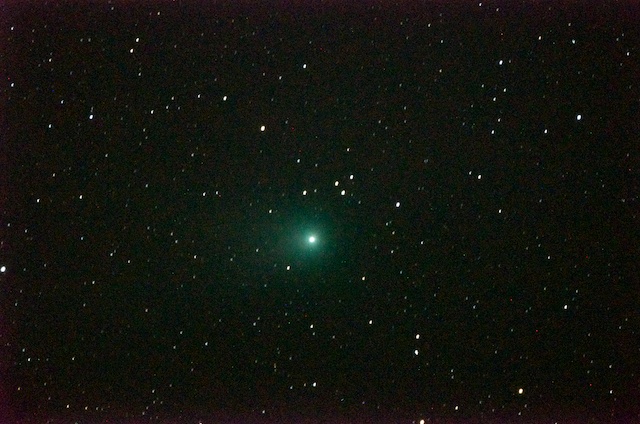
Imaging: ISS, Comet Garradd, Cassiopeia Star Spectra, Moon
Posted: 15 October 2011
The observatory was opened at 1809 MST, 86°F, to mostly clear skies, with some clouds low in the west to north sky. At 1816 MST, I took a quick look at Venus, 77X, through some tree branches. I then updated the ISS TLE in the telescope. The D7000 DSLR was mounted at 8" LX200-ACF prime focus + 3X TeleXtender. Slewed to Vega for a finderscope alignment check and a focus test using the Bahtinov Mask. At 1839 MST, I was ready for the ISS pass, scheduled to begin at 1903 MST.
The ISS pass was a good, high, bright one. Unfortunately, tracking was not very good this night. I struggled to keep the International Space Station near the finderscope crosshair. But during post-processing, there were a few frames in the 1/2000sec, ISO 6400, 4m37s, HD video recording that captured the ISS, albeit rather blurred due to the rapid motion across the FOV. One frame showed some structure:

I plan to decrease the ISO to 5000 and increase the exposure time to 1/1600sec for my next ISS imaging attempt.
I then set up to image Comet C/2009 P1 (Garradd) at prime focus (no TeleXtender). Redid the focus test on Vega using the Bahtinov Mask. Here is a good image showing the mask spikes that make focusing so easy:

I then did a 1 minute, ISO 6400, unguided exposure of the comet. Star trailing was evident, so I did 30 second exposures at various ISO settings. I then did another 1 minute, ISO 5000, unguided exposure, and it turned out fairly good:

I will use the Off-Axis Guider and guide for the next comet imaging session.
At 1936 MST, I ended comet imaging as the rising waning gibbous moon was brightening the sky. I began setting up for some spectroscopy using the Star Analyser. This night I imaged the five bright stars in the constellation of Cassiopeia that show my initials ("M", "W"). These processed images are from 1/20sec or 1/25sec, ISO 1600, exposures with the D7000 DSLR:
Imaging was ended at 2012 MST. Clouds were increasing from the west. At 2024 MST, viewed Jupiter, low in the east, at 77X and 133X. Four moons and the Great Red Spot were visible. By 2030 MST, the clouds had now reached the zenith. At 2040 MST, I took a look at the moon, still very low in the east, at 133X. There were occasionally some nice views along the terminator and limb. At 2050 MST, I set up for D7000 lunar imaging, as clouds were approaching the moon. This is a cropped, 1/400sec, ISO 200, exposure, made at prime focus + focal reducer + visual back:

Due to clouds and bright moonlight, the observatory was closed at 2125 MST, 71°F.
Go to the previous report.
Return to the Cassiopeia Observatory Welcome Page.